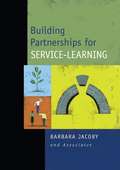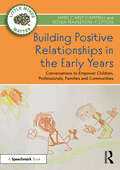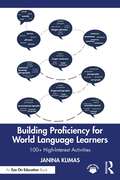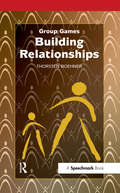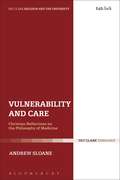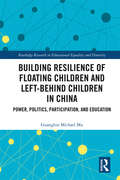- Table View
- List View
Building Parent Engagement in Schools (Non-ser.)
by Larry Ferlazzo Lorie HammondThis work is a report on the positive impact of parental involvement on their child's academics and on the school at large.Building Parent Engagement in Schools is an introduction to educators, particularly in lower-income and urban schools, who want to promote increased parental engagement in both the classroom and at home—an effort required by provisions of the No Child Left Behind Act of 2001. It is both an authoritative review of research that confirms the positive impact of parental involvement on student achievement and a guide for implementing proven strategies for increasing that involvement. With Building Parent Engagement in Schools, educators can start to develop a hybrid culture between home and school, so that school can serve as a cultural bridge for the students. Filled with the voices of real educators, students, and parents, the book documents a number of parent-involved efforts to improve low-income communities, gain greater resources for schools, and improve academic achievement. Coverage includes details of real initiatives in action, including programs for home visits, innovative uses of technology, joint enterprises like school/community gardens, and community organization efforts.
Building Partnerships for Service-Learning
by Barbara Jacoby and Associates StaffIt is clear that service-learning has the potential to yield tremendous benefits to students, communities, and institutions of higher education. Increased student learning has been well documented. As communities gain new energy to meet their needs and greater capacity to capitalize on their assets, service-learning enables higher education to fulfill its civic responsibility. When service-learning lives up to its potential to lead colleges and universities to transform themselves into fully engaged citizens of their communities and the world, its ability to bring about positive social change is limitless. To be successful, service-learning must be grounded in a wide range of solid, reciprocal, democratic partnerships. Building Partnerships for Service-Learning assembles leading voices in the field to bring their expertise to bear on this crucial topic. Faculty, administrators, student leaders, and community and corporate leaders will find this volume filled with vital information, exemplary models, and practical tools needed to make service-learning succeed. Comprehensive in scope, Building Partnerships for Service-Learning includes: Fundamentals and frameworks for developing sustainable partnerships Assessment as a partnership-building process The complex dynamics of collaboration between academic affairs and student affairs Partnering with students to enhance service-learning How to create campuswide infrastructure for service-learning Profiles and case studies of outstanding partnerships with neighborhoods, community agencies, and K-12 schools Partnerships for collaborative action research Exploring the challenges and benefits of corporate and international partnerships The dynamic relationship of service-learning and the civic renewal of higher education Building Partnerships for Service-Learning is the essential guide to taking service-learning and partnerships to the next level.
Building Positive Momentum for Positive Behavior in Young Children: Strategies for Success in School and Beyond
by Lisa RogersLearn how to use positive momentum to address common behavioral issues in the classroom and beyond. The strategies in this book show how to get long-term results, with illustrative case examples and downloadable resources for tracking progress. It also offers advice for working with children with special needs.
Building Positive Relationships in the Early Years: Conversations to Empower Children, Professionals, Families and Communities (Little Minds Matter)
by Jamel Carly Campbell Sonia Mainstone-CottonIn this unique and original book, Jamel Carly Campbell and Sonia Mainstone-Cotton come together to have an open and honest conversation about developing positive and responsive relationships in the early years. The book is divided into three main chapters – building positive relationships with children; with other professionals; and with families and the wider community – and each conversation explores a range of key themes, from building trust and listening to the voice of the child, to diversifying practice and creating a setting that represents the wider community. These discussions encourage the reader to consider the connections we make every day, to rethink and empower their practice, and to place a much higher value on their position as an early years advocate. With reflective questions included to allow the reader to think about their own practice, as well as suggested further reading to explore the themes in more depth, this engaging and accessible book is a must-read for all early years professionals – and, importantly, encourages every practitioner to begin new conversations of their own.
Building Positive Relationships in the Early Years: Conversations to Empower Children, Professionals, Families and Communities (Little Minds Matter)
by Jamel Carly Campbell Sonia Mainstone-CottonIn this unique and original book, Jamel Carly Campbell and Sonia Mainstone-Cotton come together to have an open and honest conversation about developing positive and responsive relationships in the early years. The book is divided into three main chapters – building positive relationships with children; with other professionals; and with families and the wider community – and each conversation explores a range of key themes, from building trust and listening to the voice of the child, to diversifying practice and creating a setting that represents the wider community. These discussions encourage the reader to consider the connections we make every day, to rethink and empower their practice, and to place a much higher value on their position as an early years advocate. With reflective questions included to allow the reader to think about their own practice, as well as suggested further reading to explore the themes in more depth, this engaging and accessible book is a must-read for all early years professionals – and, importantly, encourages every practitioner to begin new conversations of their own.
Building Positive Relationships with Parents of Young Children: A guide to effective communication
by Anita M. Hughes Veronica ReadPositive relationships between practitioners and parents are essential for young children’s wellbeing, but achieving this can be difficult if there is not enough understanding about how relationships work when one person (the practitioner or teacher) has to play the professional role. Strong communication skills are fundamental to this relationship and to building a sense of community between home and nursery or school. This new book explores how practitioners can build warm, friendly and caring relationships with parents. It clearly explains the dynamics of a conversation, the theory behind how relationships are formed or destroyed and provides practical strategies to put this knowledge into practice. Grounded in the theories of attachment, transactional analysis and solution focused therapy this book will help you to: Increase your level of self awareness Improve your listening skills Understand ‘how’ to communicate with different parent ‘types‘ Learn how to conduct an individual parent interview Develop professional care giving skills Full of practical examples and strategies, this text will be welcomed by early years practitioners and students who wish to develop the skills and confidence they need to effectively communicate with the parents of the children they care for.
Building Positive Relationships with Parents of Young Children: A guide to effective communication
by Anita M. Hughes Veronica ReadPositive relationships between practitioners and parents are essential for young children’s wellbeing, but achieving this can be difficult if there is not enough understanding about how relationships work when one person (the practitioner or teacher) has to play the professional role. Strong communication skills are fundamental to this relationship and to building a sense of community between home and nursery or school. This new book explores how practitioners can build warm, friendly and caring relationships with parents. It clearly explains the dynamics of a conversation, the theory behind how relationships are formed or destroyed and provides practical strategies to put this knowledge into practice. Grounded in the theories of attachment, transactional analysis and solution focused therapy this book will help you to: Increase your level of self awareness Improve your listening skills Understand ‘how’ to communicate with different parent ‘types‘ Learn how to conduct an individual parent interview Develop professional care giving skills Full of practical examples and strategies, this text will be welcomed by early years practitioners and students who wish to develop the skills and confidence they need to effectively communicate with the parents of the children they care for.
Building Powerful Learning Environments: From Schools to Communities (PDF)
by Arina BokasBuilding Powerful Learning Environments takes a close look at the trends of the Post-Digital Era through the prism of how systems of education can meet the needs of our times and offers a systemic approach to creating a different canvas for learning that aligns to these changes. At the center of the book are the concepts of a learning environment and a culture of partnerships. A learning environment has traditionally been viewed as something that educators created and sustained inside their schools. Building Powerful Learning Environments expands this understanding to embrace families, communities, other learning institutions, and businesses not as helpers, but as co-builders of a powerful learning environment. It demonstrates that schools have to take the first step in this direction by becoming the center of a new educational culture - a culture of partnerships. This book looks into various ways of creating this culture at district, school, and classroom levels. It provides practical guidance, strategies, and tips as well as some conceptual understanding of what can be done to create and support this culture at various levels of educational leadership.
Building Practice in the Dutch East Indies: Epistemic Imposition at the Beginning of the 20th Century (Architext)
by David Hutama SetiadiThis book reveals the ‘epistemic imposition’ of architectural ideas and practices by colonists from the Netherlands in the Dutch East Indies from the late-19th century onwards, exploring the ways in which this came to shape the profession up to the present day in what is now known as Indonesia. The author investigates the scope of these interventions by Dutch colonial agents in relation to existing Javanese building practices, pursuing two main lines of enquiry. The first is to examine the methods of dissemination of Dutch-taught technical knowledge and skills across the Dutch East Indies. The second is to scrutinise the effects of this dissemination upon the formation of architectural knowledge and practice within the colony. Throughout this book, the argument is made that what took place in architecture in the Dutch East Indies involved a process of disseminating building knowledge as a form of ‘epistemic imposition’ upon the indigenous citizens of the colony – in other words, as an effective instrument of Dutch colonial power. This book will be of interest to architecture academics and students interested in developing a broader global understanding of architecture, especially those interested in decolonising the teaching of architectural history and theory.
Building Practice in the Dutch East Indies: Epistemic Imposition at the Beginning of the 20th Century (Architext)
by David Hutama SetiadiThis book reveals the ‘epistemic imposition’ of architectural ideas and practices by colonists from the Netherlands in the Dutch East Indies from the late-19th century onwards, exploring the ways in which this came to shape the profession up to the present day in what is now known as Indonesia. The author investigates the scope of these interventions by Dutch colonial agents in relation to existing Javanese building practices, pursuing two main lines of enquiry. The first is to examine the methods of dissemination of Dutch-taught technical knowledge and skills across the Dutch East Indies. The second is to scrutinise the effects of this dissemination upon the formation of architectural knowledge and practice within the colony. Throughout this book, the argument is made that what took place in architecture in the Dutch East Indies involved a process of disseminating building knowledge as a form of ‘epistemic imposition’ upon the indigenous citizens of the colony – in other words, as an effective instrument of Dutch colonial power. This book will be of interest to architecture academics and students interested in developing a broader global understanding of architecture, especially those interested in decolonising the teaching of architectural history and theory.
Building Proficiency for World Language Learners: 100+ High-Interest Activities
by Janina KlimasThis innovative book offers over 100 engaging and effective activities that busy teachers can use to help students become confident, comfortable, and proficient learners, acquirers, and communicators in new languages. Many activities can be adapted to different languages and levels in secondary-level language courses.Klimas provides readers with ready-to-use templates, editable posters, as well as multimodal communicative activities such as games, storytelling exercises, ideas for centers, and more. There are also pair work and speaking, listening, and reading, as well as drama and video activities to build fluency and encourage risk-taking in the target language.Chock full of low-prep, engaging ideas, Building Proficiency for World Language Learners is an essential tool for world language and ESL teachers.
Building Proficiency for World Language Learners: 100+ High-Interest Activities
by Janina KlimasThis innovative book offers over 100 engaging and effective activities that busy teachers can use to help students become confident, comfortable, and proficient learners, acquirers, and communicators in new languages. Many activities can be adapted to different languages and levels in secondary-level language courses.Klimas provides readers with ready-to-use templates, editable posters, as well as multimodal communicative activities such as games, storytelling exercises, ideas for centers, and more. There are also pair work and speaking, listening, and reading, as well as drama and video activities to build fluency and encourage risk-taking in the target language.Chock full of low-prep, engaging ideas, Building Proficiency for World Language Learners is an essential tool for world language and ESL teachers.
Building Racial Competency in White Educators through the Transformative Act of Writing: Writing through Whiteness (Routledge Research in Race and Ethnicity in Education)
by Paul F. WalshThis book argues that the transformative act of writing can be used to strengthen the racial competency of White educators in profound ways, leading them to a more comprehensive consciousness regarding the way their racial identity impacts them personally and professionally. Through detailing the experiences of two White educators who engaged in a practice of deeply reflective personal narrative writing about their racial identity, this book presents written data from the participants and discusses the theoretical and practical implications of the participants’ written work. It also provides a strong, evidence-informed case for using reflective writing as a tool for strengthening the racial competency of White educators in order to positively impact their students, their classrooms, and their greater school communities. Lastly, the book offers writing exercises that can be applied to contexts within and outside the field of education so that readers can start the important work of further developing their racial competency. It will appeal to researchers, teacher educators, faculty, and scholars with interest in whiteness studies and advancing anti-racist pedagogies, as well as literacy education and diversity and equity in education.
Building Racial Competency in White Educators through the Transformative Act of Writing: Writing through Whiteness (Routledge Research in Race and Ethnicity in Education)
by Paul F. WalshThis book argues that the transformative act of writing can be used to strengthen the racial competency of White educators in profound ways, leading them to a more comprehensive consciousness regarding the way their racial identity impacts them personally and professionally. Through detailing the experiences of two White educators who engaged in a practice of deeply reflective personal narrative writing about their racial identity, this book presents written data from the participants and discusses the theoretical and practical implications of the participants’ written work. It also provides a strong, evidence-informed case for using reflective writing as a tool for strengthening the racial competency of White educators in order to positively impact their students, their classrooms, and their greater school communities. Lastly, the book offers writing exercises that can be applied to contexts within and outside the field of education so that readers can start the important work of further developing their racial competency. It will appeal to researchers, teacher educators, faculty, and scholars with interest in whiteness studies and advancing anti-racist pedagogies, as well as literacy education and diversity and equity in education.
Building Reasoning and Problem-Solving Skills in Children with Autism Spectrum Disorder: A Step by Step Guide to the Thinking In Speech® Intervention
by Janice NathanPresenting an innovative, research-based approach to help children with an Autism Spectrum Disorder (ASD) develop reasoning and problem-solving skills. The book also shows how to teach children to recognise and cope with feelings of anxiety and stress that often accompany independent problem-solving, in order to avoid emotional dysregulation.
Building Relationships (Group Games)
by Thorsten Boehner Lilo SeelosGroup Games: Building Relationships Thorsten Boehner - A comprehensive collection of 140 games and activities to foster personal development; improve social communication skills; and strengthen group dynamics. Full of practical and creative ideas that can be implemented with minimal preparation and equipment. 140 games and activities to foster personal development; improve social communication skills; and strengthen group dynamics. Full of practical and creative ideas that can be implemented with minimal preparation and equipment. Suitable for all ages, the games will increase self- and other-awareness; improve recognition of one's own limits as well as awareness of the limits of others; encourage better teamwork skills; and increase flexibility as participants gain new experiences in a playful and safe environment. Includes: Group gel activities; Warm-up activities; Exercises for building trust and awareness; Imagination and improvisation; Closing exercises; Special exercises and tips for amateur dramatics lovers.
Building Relationships (Group Games)
by Thorsten Boehner Lilo SeelosGroup Games: Building Relationships Thorsten Boehner - A comprehensive collection of 140 games and activities to foster personal development; improve social communication skills; and strengthen group dynamics. Full of practical and creative ideas that can be implemented with minimal preparation and equipment. 140 games and activities to foster personal development; improve social communication skills; and strengthen group dynamics. Full of practical and creative ideas that can be implemented with minimal preparation and equipment. Suitable for all ages, the games will increase self- and other-awareness; improve recognition of one's own limits as well as awareness of the limits of others; encourage better teamwork skills; and increase flexibility as participants gain new experiences in a playful and safe environment. Includes: Group gel activities; Warm-up activities; Exercises for building trust and awareness; Imagination and improvisation; Closing exercises; Special exercises and tips for amateur dramatics lovers.
Building Relationships and Communicating with Young Children: A Practical Guide for Social Workers
by Karen WinterWhy is it important for social workers to form meaningful relationships with young children on their caseloads? And how can social workers develop meaningful relationships with these young children? This book provides a timely, invaluable resource and practical guide for social work students specialising in family and child care and for practitioners who have young children on their caseloads. Packed with real life examples of in-depth interviews conducted with young children known to social services, it outlines what can be done to improve practice in this challenging and demanding area. Building Relationships and Communicating with Young Children is the first book to bring to life the perspectives of young children and to highlight their competency within the interview process. It: explores the key ingredients required by social workers to establish, maintain, nurture and value their relationships with young children highlights what young children, within the context of meaningful relationships with social workers, can tell us about their circumstances, their perspectives, their feelings and their views uses case examples to identify best practice guidelines including methods and techniques for social workers to build meaningful relationships with young children on their caseloads makes recommendations regarding how best to positively engage and work with young children. Written by a social worker and university lecturer with 16 years experience of working in the field of child protection, this textbook is full of case studies and practical advice about how to form relationships with young children known to social services, the most appropriate methods to use and how to represent their perspectives. It is essential reading for all social work students as well as social work practitioners and other social and health care professionals.
Building Relationships and Communicating with Young Children: A Practical Guide for Social Workers
by Karen WinterWhy is it important for social workers to form meaningful relationships with young children on their caseloads? And how can social workers develop meaningful relationships with these young children? This book provides a timely, invaluable resource and practical guide for social work students specialising in family and child care and for practitioners who have young children on their caseloads. Packed with real life examples of in-depth interviews conducted with young children known to social services, it outlines what can be done to improve practice in this challenging and demanding area. Building Relationships and Communicating with Young Children is the first book to bring to life the perspectives of young children and to highlight their competency within the interview process. It: explores the key ingredients required by social workers to establish, maintain, nurture and value their relationships with young children highlights what young children, within the context of meaningful relationships with social workers, can tell us about their circumstances, their perspectives, their feelings and their views uses case examples to identify best practice guidelines including methods and techniques for social workers to build meaningful relationships with young children on their caseloads makes recommendations regarding how best to positively engage and work with young children. Written by a social worker and university lecturer with 16 years experience of working in the field of child protection, this textbook is full of case studies and practical advice about how to form relationships with young children known to social services, the most appropriate methods to use and how to represent their perspectives. It is essential reading for all social work students as well as social work practitioners and other social and health care professionals.
Building Research Capacity at Universities: Insights from Post-Soviet Countries
by Maia Chankseliani Igor Fedyukin Isak FruminThis edited volume represents a collective contribution to the current debates on developing university research capacity. The chapters in this volume offer empirical case studies from post-Soviet countries which share a common history, common policies and practices of higher education. These commonalities make the regional focus meaningful and analytically valid. At the same time, the case studies demonstrate divergence from the shared Soviet tradition and offer historical, sociological, and political analyses of how and in what ways universities in former Soviet countries internalised their research mission and developed the capacity to carry out this mission. This volume is the first of its kind to examine national and institutional resources, political will, and individual agency to understand how these influenced universities’ motivation, expertise, and opportunities of undertaking research since the early 1990s, and how universities changed their structures and practices under these influences. The book will appeal to students and scholars in the fields of education, sociology, political science, and economics.
Building Research Design in Education: Theoretically Informed Advanced Methods
by Lorna Hamilton John RavenscroftBuilding Research Design in Education provides insights into the ways in which foundational knowledge of research and research processes can be applied in order to build rigorous research design. If your research is to have meaning and value, this text will enable you to make informed choices and decisions about your design, bearing in mind the complex ideas and theoretical framing needed to underpin it.Drawing on the research expertise of the contributors, this text initially introduces the foundations for differing ideas around epistemology and ontology, then splits into four parts looking at quantitative, qualitative and mixed methods research approaches as well as other possibilities for research, including newer or emerging forms of research. Throughout, good research design is shown as taking many shapes with its premise always being rooted in a clear understanding of what is known and what is knowable according to the researcher's world view, in harmony with epistemological and ontological roots. Chapters include learning activities, case examples of international research, essential reading, as well as further advanced reading suggestions, and online resources with additional exemplars and activities. This book is for the advanced student who already has an insight into the basics of research and is wanting to ensure a robust approach to research construction and reflection.
Building Research Design in Education: Theoretically Informed Advanced Methods (Berg New Media Ser.)
by Lorna Hamilton John RavenscroftBuilding Research Design in Education provides insights into the ways in which foundational knowledge of research and research processes can be applied in order to build rigorous research design. If your research is to have meaning and value, this text will enable you to make informed choices and decisions about your design, bearing in mind the complex ideas and theoretical framing needed to underpin it.Drawing on the research expertise of the contributors, this text initially introduces the foundations for differing ideas around epistemology and ontology, then splits into four parts looking at quantitative, qualitative and mixed methods research approaches as well as other possibilities for research, including newer or emerging forms of research. Throughout, good research design is shown as taking many shapes with its premise always being rooted in a clear understanding of what is known and what is knowable according to the researcher's world view, in harmony with epistemological and ontological roots. Chapters include learning activities, case examples of international research, essential reading, as well as further advanced reading suggestions, and online resources with additional exemplars and activities. This book is for the advanced student who already has an insight into the basics of research and is wanting to ensure a robust approach to research construction and reflection.
Building Resilience of Floating Children and Left-Behind Children in China: Power, Politics, Participation, and Education (Routledge Research in Educational Equality and Diversity)
by Guanglun Michael MuThe past two decades have seen exponential growth of urbanisation and migration in China. Emerging from this growth is a population of floating and left-behind children which is estimated to be approaching 100 million. Due to their increasing risks of undesirable educational and social, as well as health and psychological, outcomes, there is a great urgency to help floating children and left-behind children beat the odds. This book offers an analysis of how oscillations of government discourse have come to shape central and local educational policies regarding the schooling of these children. It also delves into child and youth resilience in this unique migration context, examining what can be done to build up resilience of floating and left-behind children. In this vein, the book will complement current knowledge and advance context- and culture-specific understandings of child and youth resilience through both school-based and community-based approaches. The book aims to answer a fundamental question: How to help floating children and left-behind children become responsive and resilient to structural deficiencies and dynamics in the migration context of China? This is important reading for scholars, school professionals, community workers, and policy makers to better address the social and educational resilience and wellbeing of floating and left-behind children.
Building Resilience of Floating Children and Left-Behind Children in China: Power, Politics, Participation, and Education (Routledge Research in Educational Equality and Diversity)
by Guanglun Michael MuThe past two decades have seen exponential growth of urbanisation and migration in China. Emerging from this growth is a population of floating and left-behind children which is estimated to be approaching 100 million. Due to their increasing risks of undesirable educational and social, as well as health and psychological, outcomes, there is a great urgency to help floating children and left-behind children beat the odds. This book offers an analysis of how oscillations of government discourse have come to shape central and local educational policies regarding the schooling of these children. It also delves into child and youth resilience in this unique migration context, examining what can be done to build up resilience of floating and left-behind children. In this vein, the book will complement current knowledge and advance context- and culture-specific understandings of child and youth resilience through both school-based and community-based approaches. The book aims to answer a fundamental question: How to help floating children and left-behind children become responsive and resilient to structural deficiencies and dynamics in the migration context of China? This is important reading for scholars, school professionals, community workers, and policy makers to better address the social and educational resilience and wellbeing of floating and left-behind children.
Building School 2.0: How to Create the Schools We Need
by Chris Lehmann Zac ChaseNinety-five propositions for creating more relevant, more caring schools There is a growing desire to reexamine education and learning. Educators use the phrase "school 2.0" to think about what schools will look like in the future. Moving beyond a basic examination of using technology for classroom instruction, Building School 2.0: How to Create the Schools We Need is a larger discussion of how education, learning, and our physical school spaces can—and should—change because of the changing nature of our lives brought on by these technologies. Well known for their work in creating Science Leadership Academy (SLA), a technology-rich, collaborative, learner-centric school in Philadelphia, founding principal Chris Lehmann and former SLA teacher Zac Chase are uniquely qualified to write about changing how we educate. The best strategies, they contend, enable networked learning that allows research, creativity, communication, and collaboration to help prepare students to be functional citizens within a modern society. Their model includes discussions of the following key concepts: Technology must be ubiquitous, necessary, and invisible Classrooms must be learner-centric and use backwards design principles Good technology can be better than new technology Teachers must serve as mentors and bring real-world experiences to students Each section of Building School 2.0 presents a thesis designed to help educators and administrators to examine specific practices in their schools, and to then take their conclusions from theory to practice. Collectively, the theses represent a new vision of school, built off of the best of what has come before us, but with an eye toward a future we cannot fully imagine.

